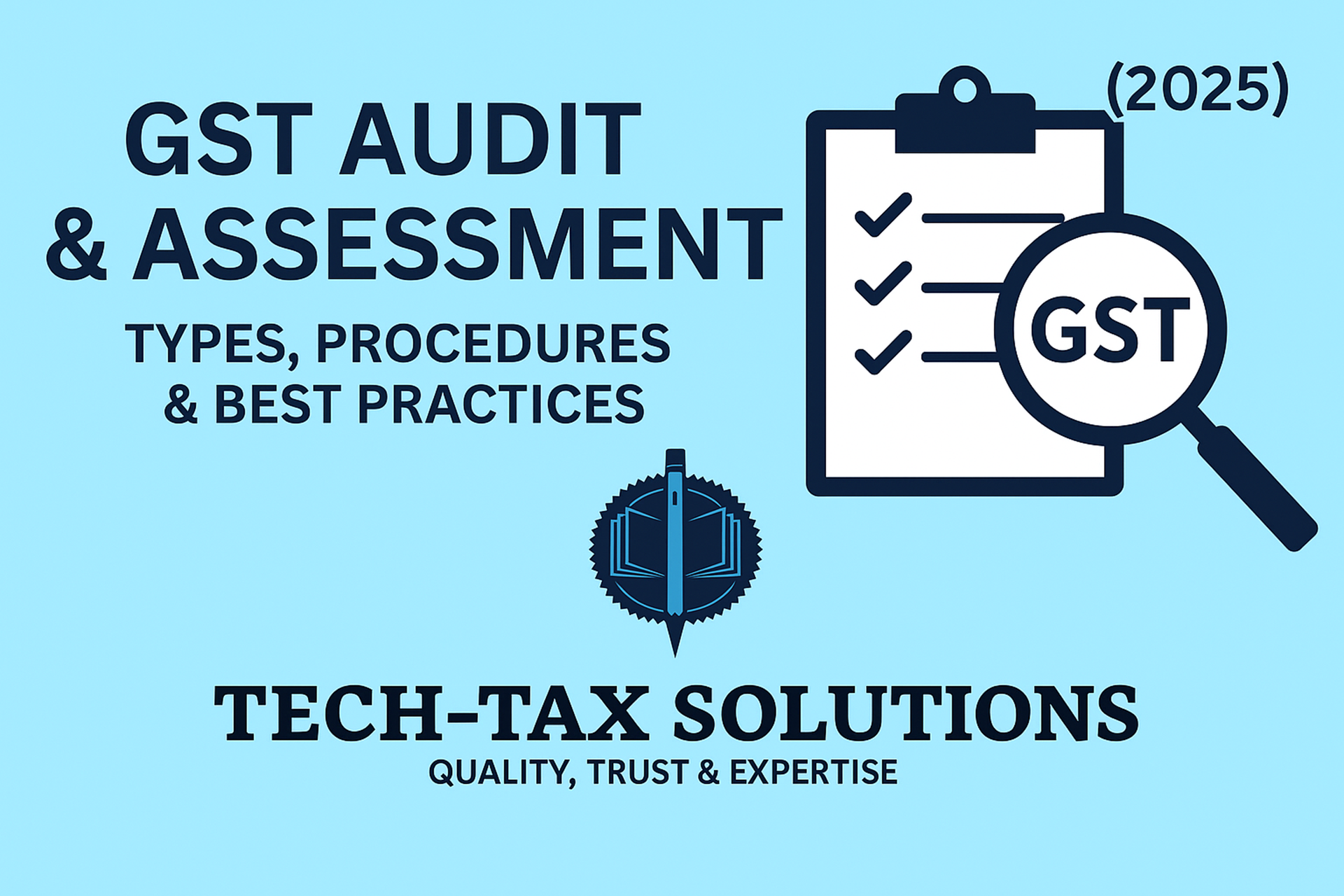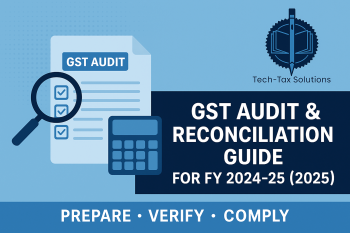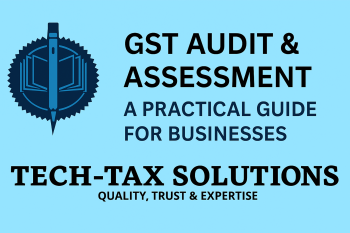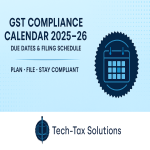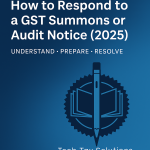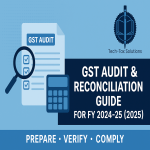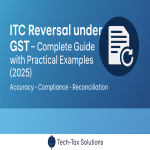🔹 Introduction
GST law provides for audit and assessment to verify the correctness of returns, ITC claims, and overall compliance. With data-driven scrutiny by GSTN, audits and assessments have become more rigorous in 2025. Non-compliance can lead to penalties, interest, and notices under Sec. 74A.
(Reference: Sec. 65, 66, 74A of CGST Act; Rule 101–104 of CGST Rules; CBIC instructions till 2025)
🔹 Types of GST Audit
✅ 1. Departmental Audit (Sec. 65)
-
Conducted by Commissioner or authorized officer.
-
Advance notice of 15 days given in Form ADT-01.
-
Audit must be completed within 3 months (extendable to 6 months).
✅ 2. Special Audit (Sec. 66)
-
Ordered by Assistant/Deputy Commissioner with approval of Commissioner.
-
Conducted by nominated CA/CMA.
-
Required if valuation or ITC credit is in doubt.
✅ 3. CAG/AG Audit (Sec. 65(6))
-
Comptroller & Auditor General may audit GST accounts of Government departments and PSU entities.
🔹 Types of Assessment under GST
✅ 1. Provisional Assessment (Sec. 60)
-
Allowed when taxpayer is unable to determine tax liability.
-
Bond & security may be required.
✅ 2. Scrutiny of Returns (Sec. 61)
-
Officer scrutinizes GSTR-1, 3B & 2B for mismatches.
-
Discrepancies communicated in Form ASMT-10.
✅ 3. Best Judgment Assessment (Sec. 62)
-
Done when taxpayer fails to file returns.
-
Officer assesses liability to best of judgment.
✅ 4. Summary Assessment (Sec. 64)
-
Immediate assessment in interest of revenue, with Commissioner’s approval.
🔹 Step-by-Step GST Audit Procedure
📌 Step 1: Notice in Form ADT-01 issued at least 15 days before audit.
📌 Step 2: Taxpayer provides records (invoices, ledgers, ITC registers).
📌 Step 3: Officers examine turnover, ITC, exemptions, refunds, E-way bills.
📌 Step 4: Audit report issued in Form ADT-02.
📌 Step 5: If discrepancies found → demand raised under Sec. 74A.
🔹 Step-by-Step GST Assessment Procedure
📌 Step 1: Scrutiny notice in ASMT-10 issued.
📌 Step 2: Taxpayer replies via ASMT-11.
📌 Step 3: If unsatisfactory, officer may proceed to demand order.
📌 Step 4: In non-filing cases, best judgment order issued.
📌 Step 5: Taxpayer can appeal under Sec. 107.
🔹 Practical Examples
Example 1: Trader in Ghaziabad
Fails to file GSTR-3B for 3 months. Department issues best judgment assessment order. Trader files appeal, pays liability + interest.
Example 2: Exporter in Noida
Refund claim of ₹50 lakh under LUT flagged for mismatch in invoices. Special audit ordered under Sec. 66. CA audit confirms excess refund claimed. Refund reversed + penalty imposed.
Example 3: Service Provider in Delhi
Mismatch between GSTR-1 turnover ₹5 crore and books turnover ₹5.2 crore. Scrutiny notice issued. Taxpayer reconciles with debit notes and resolves without demand.
🔹 Common Mistakes Leading to Audit Issues
-
Claiming ITC on blocked items (Sec. 17(5)).
-
Not reconciling GSTR-1 vs books vs 26AS.
-
Excess refund claims without documentation.
-
Ignoring scrutiny notices (ASMT-10).
🔹 Penalties under Sec. 74A (from FY 2024-25)
-
Wrongful ITC claim or tax suppression → Tax + Interest + Penalty (100%).
-
Fraudulent invoices → Higher penalties + prosecution under Sec. 132.
🔹 Best Practices for Audit & Assessment
-
✅ Maintain proper books & GST reconciliations.
-
✅ Do quarterly self-audit.
-
✅ Keep export/ refund documents ready.
-
✅ Respond promptly to notices.
-
✅ Engage professionals for audit representation.
🔹 FAQs
Q1. Is GST audit by CA mandatory?
➡️ No, self-certification in GSTR-9C is sufficient. Special audit may be ordered by officer.
Q2. Can audit extend beyond 6 months?
➡️ Only with Commissioner’s approval.
Q3. Can taxpayer challenge best judgment assessment?
➡️ Yes, appeal under Sec. 107.
Q4. What if taxpayer ignores audit notice?
➡️ Officer can raise demand order with penalty.
Q5. Are scrutiny notices common?
➡️ Yes, based on automated data mismatch detection.
🔹 Conclusion
GST audits and assessments are now data-driven and frequent. Timely reconciliations, correct ITC claims, and compliance with notices are key to avoiding penalties. Businesses must prepare proactively to handle departmental scrutiny.
📌 Need expert help in GST audit preparation, departmental notices, or assessment appeals?
Contact Tech-Tax Solutions – Quality, Trust & Expertise in Ghaziabad, Noida & Delhi.
